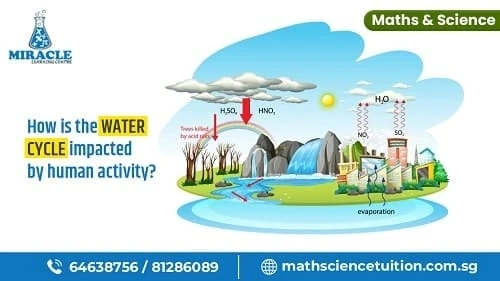The water cycle is a complex natural system that maintains the continuous flow of water between the atmosphere, land, and oceans, which is vital for sustaining life on our planet. Both climate change and human activities play significant roles in shaping the dynamics of this intricate system. Climate change typically results in increased atmospheric temperatures and alterations in precipitation patterns. Additionally, human activities such as water extraction, changes in land use, and hydraulic construction directly or indirectly influence the water cycle. This article, guided by the science tuition of Miracle Learning Centre, explores various human activities that exert a considerable impact on the water cycle and scrutinizes their consequences on the environment.
What is the Water Cycle?
The water cycle is like a never-ending dance of water on Earth. When the Sun shines, water on the ground turns into tiny bits called water vapour and goes up into the sky. These vapour bits join together and make clouds. Later, the clouds get heavy, and the water falls back down as rain or other things like snow. Some of it goes into the ground, some flows in rivers, and plants also let water out through their leaves. This water cycle keeps happening over and over, making sure there\'s always fresh water for us to use and for all living things on our planet to thrive.
Impacts of Human Activities on Water Cycle
- Urbanization and Deforestation:
One of the most prominent ways in which human activities impact the water cycle is through urbanization and deforestation. As cities expand, natural landscapes are replaced by impervious surfaces like concrete and asphalt. This alteration prevents rainwater from infiltrating the ground and replenishing underground aquifers. Instead, rainwater quickly runs off these surfaces, causing increased surface runoff. This excess water can lead to flooding in urban areas and disrupt natural drainage patterns.
Deforestation is another significant factor. When trees are cut down to make way for urban development or agriculture, the process of transpiration is disrupted. Trees release water vapour through their leaves, contributing to the humidity in the atmosphere. Without trees, less water vapour is released, which can affect regional rainfall patterns and reduce overall moisture in the air.
- Glaciers and Ice Sheets:
The melting of glaciers and ice sheets, driven by human-induced climate change, disrupts the water cycle in multiple ways. As these icy giants shrink, they release freshwater into rivers and oceans, altering the availability of water for ecosystems and human use. This can lead to water scarcity and changes in streamflow patterns, affecting both natural habitats and communities. Furthermore, the resulting rise in sea levels threatens coastal regions, causing erosion and saltwater intrusion. The loss of reflective ice surfaces also amplifies warming, contributing to a feedback loop in climate change. In addition to these environmental impacts, the transformation of icy landscapes endangers unique ecosystems adapted to cold environments.
- Agriculture and Irrigation:
Agriculture is vital for sustaining human populations, but it also has a substantial impact on the water cycle. The extensive use of irrigation systems to grow crops in arid regions consumes vast amounts of water. This water is drawn from rivers, lakes, and underground aquifers, depleting these sources and reducing the natural flow of water through the landscape.
Moreover, agriculture involves the use of fertilizers and pesticides, which can contaminate surface water and groundwater. These pollutants can disrupt aquatic ecosystems and pose health risks to both humans and wildlife, further emphasizing the need for proper science tuition to understand the consequences of these actions.
- Industrial Processes:
Industrial activities are notorious for their water consumption and pollution. Manufacturing processes, power generation, and mining operations often require significant amounts of water for cooling, cleaning, and chemical reactions. In many cases, the water used is withdrawn from natural sources and returned as heated or contaminated effluents.
These discharges can disrupt local water temperatures and aquatic ecosystems, affecting the habitat and survival of aquatic species. The chemicals and pollutants released can also infiltrate groundwater, posing threats to drinking water sources and the overall quality of water bodies.
- Groundwater Depletion:
Groundwater, which makes up a significant portion of the Earth\'s freshwater resources, is being extracted at unsustainable rates in many parts of the world. This over-extraction affects the water table and can lead to land subsidence, a phenomenon where the land surface sinks as the aquifers beneath it are drained. This, in turn, disrupts natural groundwater flow patterns and reduces the availability of water for both human consumption and natural ecosystems.
How does science tuition contribute to a better grasp of the water cycle?
Understanding how the water cycle works is pretty tricky. But learning about it through science tuition can make it easier. Miracle Learning Centre is a well recognized science tuition centre in Singapore. Here, students can learn all about how human activities affect the water cycle.
Students can find highly skilled educators at Miracle Learning Centre, who employ innovative teaching techniques. The centre places a strong emphasis on hands-on learning and interactive lessons, making it easier for students to gain a deeper understanding of our planet\'s water cycle.These approaches make even the most challenging scientific concepts accessible to students.
Conclusion:
Human activities have a profound impact on the water cycle, disrupting the delicate balance that sustains life on Earth. It is imperative that we adopt sustainable practices, reduce our water consumption, and take steps to protect and restore the natural systems that regulate the water cycle. Science tuition from Miracle Learning Centre can be a valuable resource for students looking to improve their understanding of the water cycle. They equip the next generation with the knowledge and tools needed to address these challenges.



